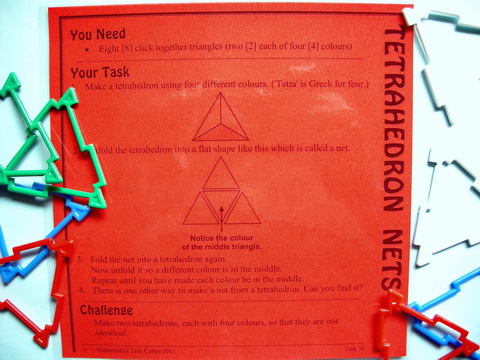
Tetrahedron NetsTask 32 ... Years 2 - 10SummaryBy making a tetrahedron and unfolding it to make its net, students discover its symmetric properties. The challenge is extended to looking for an alternative net and to discovering that 3D objects can be reflected. |
MaterialsContent
|

IcebergA task is the tip of a learning iceberg. There is always more to a task than is recorded on the card.



|
On The Card
The tetrahedron you make in this task is a Size 1 tetrahedron. A Size 2 tetrahedron has each face made like the picture opposite.
|
Whole Class InvestigationTasks are an invitation for two students to work like a mathematician. Tasks can also be modified to become whole class investigations which model how a mathematician works. |
The best way to satisfactorily turn this task into a whole class lesson is to have sufficient 3d Geoshape Triangles (at least 200). The questions and problems above can be used to guide the investigation. Some exploration of tetrahedra can take place with newspaper rolled into tubes. Use only three small pieces of masking tape to hold each roll in its tube shape. Tubes with diameter about the thickness of a thumb form the edges. Joiners are made by rolling the newspaper into very tight rolls and again holding with three strips of masking tape. These are then cut through the middle piece of tape to make two 'half' rolls. Bending these in two makes V shape joiners which fit into the ends of the tubes. At this stage Tetrahedron Nets does not have a matching lesson on Maths300. |
Is it in Maths With Attitude?Maths With Attitude is a set of hands-on learning kits available from Years 3-10 which structure the use of tasks and whole class investigations into a week by week planner. |
Tetrahedron Nets is not in any MWA kit. However it can be used to enrich the Space & Logic kit at Years 5/6 and Years 9/10. This task is included in the Task Centre Kit for Aboriginal Students. |